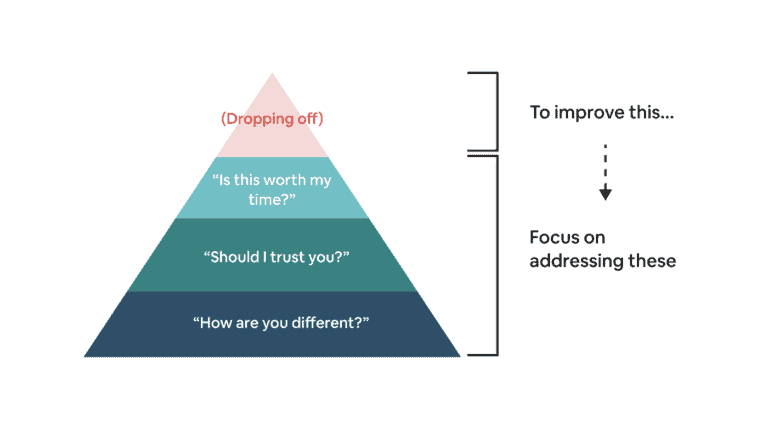It’s no secret that product-led growth is getting its moment in the spotlight. Every SaaS company is adopting reverse trial, usage-based pricing, personalized onboarding, yada yada yada.
But if you look closely, there is one thing that truly sets top PLG companies — Notion, Zapier, Canva, Miro, Figma, Airtable — apart from the crowd: a thriving ecosystem.
You might be thinking, “Of course they do. These are popular products with massive user bases.”
But a large user base doesn’t automatically form an ecosystem. Many products that became popular through short-lived virality and ad-fueled acquisition have never created a meaningful network effect among their users.
In fact, I’d argue that every company mentioned above is successful today precisely because of their early investment in ecosystem building, in addition to having a great product.
But how exactly do you build an ecosystem?
To demystify the concept of ecosystem building, I want to share a few common growth loops you can use to build an ecosystem, examples from successful companies, and actionable tips you can follow.
If you are part of a SaaS company that wants to get an ecosystem started, keep on reading
Why build an ecosystem
Before we dive in, let’s first talk about what makes ecosystems so powerful.
1. An ecosystem can’t be copied
SaaS companies can no longer compete on features alone because features have become extremely easy to copy. Given enough time, most products within a category will look more or less the same.
Don’t believe me? Let’s do a quick exercise:
- Search for “email marketing software.”
- Look at the first three products that come up.
- Tell me how exactly they are different.
You most likely cannot.
But unlike product features, an ecosystem can’t be copied.
Take YouTube, for example: Even if you somehow get access to its codebase and build a clone, without all the creators and content, the product won’t make a dent in the market.
And this is what makes an ecosystem such a defensible strategy.
2. An ecosystem helps you go after different segments at scale
Another common attribute among top SaaS companies today is the horizontal nature of their products.
The good thing about having a horizontal product is the large TAM (total addressable market) that comes with it.
The downside, however, is that you cannot effectively go after all your user segments at scale. If you try to focus on one segment at a time, you risk your product being labeled as a “vertical solution.”
Luckily, with the help of an ecosystem, horizontal SaaS can now tap into a wide range of industries, departments, geo-markets, and use cases in a scalable fashion.
Now that we understand why ecosystems work, let’s talk about how to build one.
SaaS companies often use three growth loops to build an ecosystem: user-generated templates, experts, and extensions.
Let’s dive into them one by one.
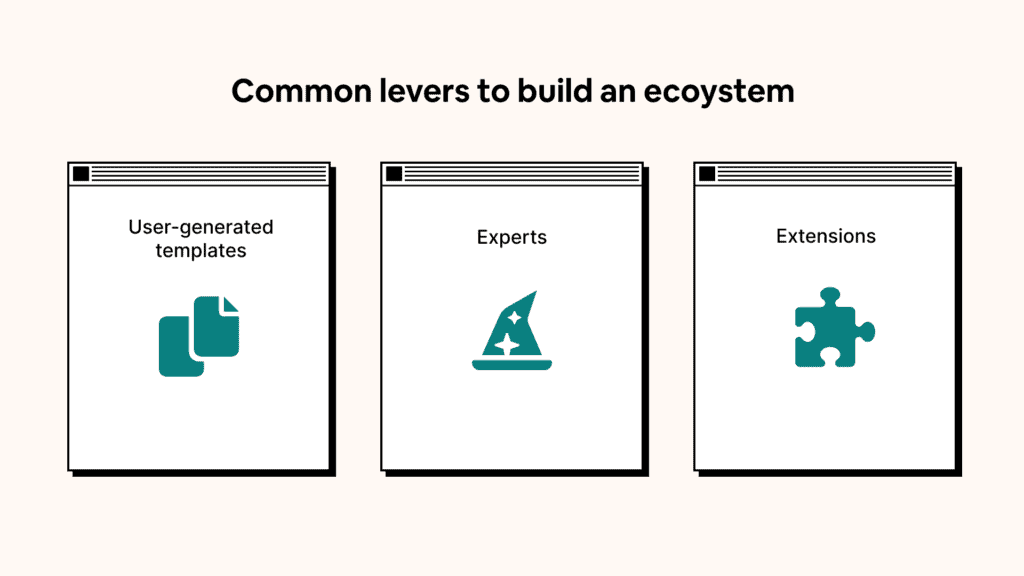
User-generated templates
Templates are a table-stake feature in most SaaS products today. They are useful for a few reasons:
- They offer a “fill-in-the-blank” onboarding experience to activate new users.
- They showcase your features with live examples.
- They adapt your products for different segments.
However, most of the templates you see are still built by the SaaS companies themselves, making the template creation process unscalable.
User-generated templates not only solve this problem but also enable a new growth loop:
- A power user creates and shares a template.
- A new user uses the template.
- The new user becomes a power user.
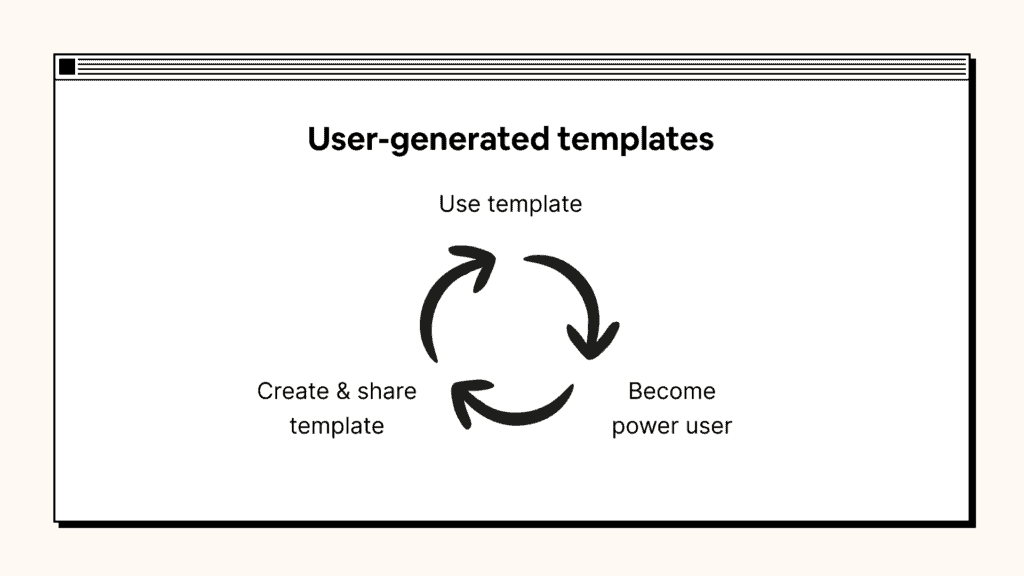
The most impressive aspect of this loop is its compounding effect. A single power user can create multiple templates, each template can be used by many users, and the loop can be replicated across all your user segments.
No matter how efficient your team is at creating templates, you can never do so faster than your community. So why not get them involved?
Example: Miro
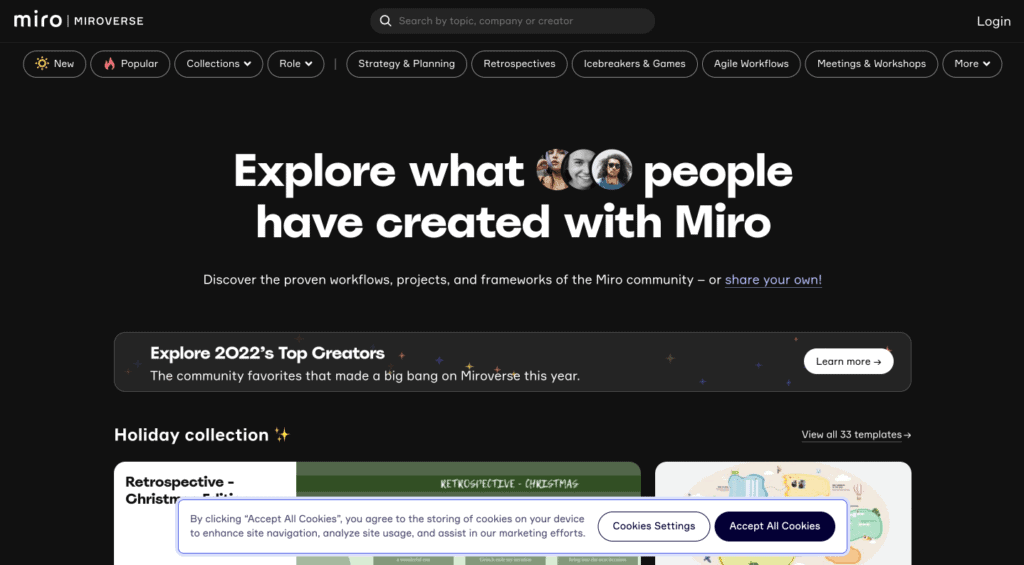
During the pandemic, the demand for Miro’s whiteboarding tool grew explosively as businesses needed a way to collaborate remotely.
The team at Miro knew they didn’t have the expertise and capacity to build for every use case, so they enlisted their power users to help with template creation. Since many of Miro’s early power users were consultants, they gladly offered their help in exchange for an opportunity to promote their services.
As a result, Miroverse was launched. The template creators got a new channel to generate leads, Miro got free content, and their users got more templates — a win-win-win for everyone.
Fast forward two years later, Miroverse now has more than 1,000 community-sourced templates, making it one of Miro’s strongest growth loops.
Related read: Into the Miroverse – the community-driven story of a billion dollars!
Example: Canva

Canva’s value proposition is to “empower everyone in the world to design anything and publish anywhere.” To make this a reality for non-designers, the product must offer design templates and assets in various formats and styles.
The team at Canva made this possible by launching the Canva Creators program. Under this program, third-party designers can upload their designs and earn royalties based on performance.
These user-generated templates not only increase Canva’s value as a product but also keep professional designers, who are typically users of Photoshop or Illustrator, in Canva’s ecosystem.
Based on the data published in June 2021, the annualized total royalty pool for Canva creators had reached $27.6M USD — nearly 3X compared with the year prior.
(As an added bonus, the user-generated templates also feed into Canva’s content & SEO strategy.)
Experts
You can typically find three types of value-added experts in a SaaS ecosystem: agencies, educators, and community advocates.
1. Agencies
Agencies (aka service partners) are experts who can set up your product for other users. Their profiles can range from part-time freelancers all the way to large agencies.
To a SaaS company, agencies provide value in two ways:
- If a user needs assistance that falls outside the scope of your customer support, you can refer them to an agency. If the agency does the job well, the customer will get more value from your product, resulting in longer retention.
- Most agencies offer more than one type of service. They can bundle your product into their services to help you acquire adjacent users.

Some might ask, “Why don’t SaaS companies just offer professional services to keep this portion of revenue?”
Well, unless you are selling to the enterprise market and have a high ARPA (average revenue per account), the ROI is unlikely to be worth it.
Additionally, most agencies don’t just implement your product. They also help clients with business operations, custom development, and custom integrations. Most SaaS companies aren’t set up to offer these services, which is why they’d rather outsource the work to third-party agencies.
Example: HubSpot

The best agency program example is probably HubSpot’s Solution Partner Program.
There are about 7,000 HubSpot agency partners across different industries, expertise, and geo-markets. They receive leads, dedicated training, a channel account manager, priority support, white-labeled content, revenue sharing, and performance-based badges from HubSpot. In return, HubSpot gets 7,000 self-organized sales and service teams across the world.
Rumor has it that 40% of HubSpot’s revenue is associated with its agency program. I can’t verify whether this is true, but it’s certainly believable considering how much HubSpot has invested in the program.
2. Educators
Educators are experts who create tutorials, courses, or training around your product.
Although every SaaS company already produces its own help content, meeting everyone’s learning style is impossible. This is where educators can come in to fill the gap.
We are seeing more and more independent content creators capable of producing high-quality tutorials that are both informative and entertaining. Because each educator can afford to focus on a niche, it is much easier for them to speak their audience’s language, both metaphorically and literally.
These educators typically fall into two categories:
The first category consists of those who create content for a specific product. This usually happens when a product is so widely used that it becomes a skill in itself.
Example: Excel

Excel is the OG of modern software. No matter what fancy new SaaS product comes out tomorrow, Excel (or its cousin Google Sheets) will always be its competition in one way or another.
This high demand makes teaching Excel a lucrative business, which is why you see over 600 million results by googling “Excel tutorials.”
(Off-topic: I only recently learned that competitive Excel is an actual sport!)
The other type of educator teaches a broader subject through your product.
Example: Softr

Since the rise of no-code platforms, there has been a surge of content created around no-code development. But “no-code” isn’t limited to one particular tool. Instead, it includes a wide range of products for different use cases.
At Softr, we often see influencers choose our web app builder to teach others how to build client portals and internal tools. To support them, we always try to come up with co-marketing ideas, exclusive perks, or other forms of partnership.
Some think this extra help is unnecessary when the educators are already promoting our product, but we see it as a way to foster long-term relationships and make the pie bigger for everyone.
Enjoying this post so far? Subscribe for more.
3. Community advocates
Community building has been a hot topic over the past few years. Almost every SaaS company wants to build a community of their own.
However, they all get hit by the same reality:
- Community management as a function is still in its early days, making strong community managers hard to find.
- Community initiatives are labor-intensive. It requires tons of human involvement to moderate discussions, host events, or run contests.
To overcome these challenges, some companies have found a smart solution by turning their loyal community members into community advocates. These advocates would help the core team with community management in exchange for rewards.
Not only does this strategy amplify the community spirit, but it also eases the capacity challenge every community team runs into.
Example: Notion

Very few SaaS companies run a community better than Notion does.
Their best-known community initiative is the Notion Ambassador Program, which recruits volunteers to run local communities across the globe. In exchange, the ambassadors get early feature access, AMAs with team members, priority support, and, most importantly, the right to monetize based on their status.
At the time of writing, Notion has over 80 self-organized communities and 30 monthly in-person events across the globe. And the most impressive part? They are able to manage a community at this scale with only three full-time team members!
Considering Notion’s recent valuation at $10 billion, I’d say this community-led strategy has served them very well.
Related read: How Notion leveraged community to build a $10B business | Camille Ricketts
What about affiliates?
You might have noticed that I didn’t mention anything about affiliates. That’s because an affiliate program is simply an incentive structure.
If you ask any affiliate program manager, they will tell you that their top performers fall into at least one of the categories mentioned above.
Extensions
Extensions (aka plug-ins) are third-party apps that either complement or expand the capabilities of your product. They could range from micro add-ons built by indie developers to standalone products built by other SaaS companies.
These extensions fill the holes in your product, preventing customers from switching to competitors. If an extension “multi-tenant” on similar products, it can even become a new source of user acquisition.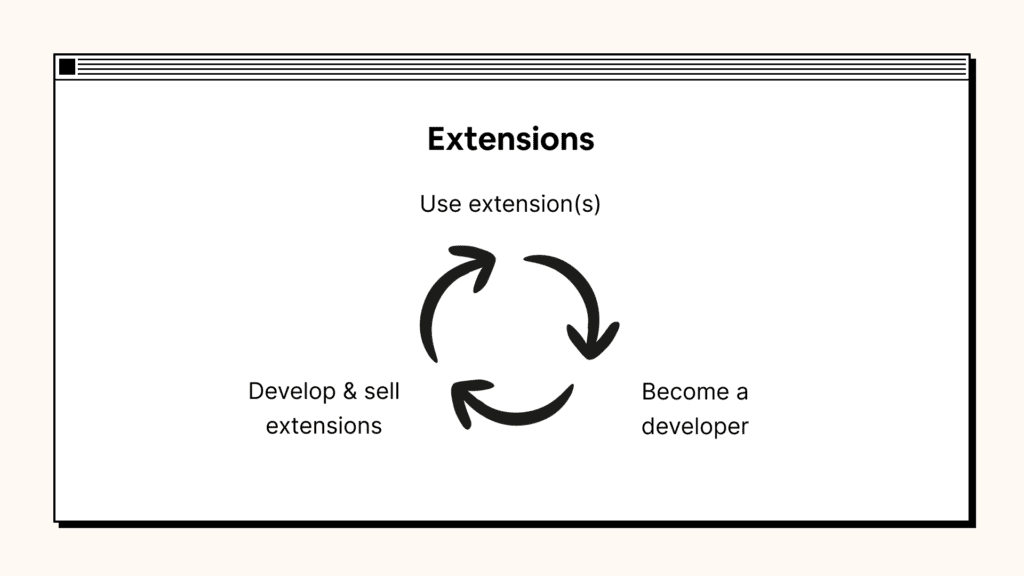
But don’t get too excited yet. While these all sound fantastic, getting others to build extensions for you is not an easy feat.
For starters, you will have to create an external API and an SDK. They will need to strike a good balance between flexibility, security, and ease of adoption.
You will also need a team to recruit external developers, offer technical support, and manage ongoing relationships. Due to the technical nature of these activities, your regular community team likely won’t cut it. To effectively support developers, you will need to assemble a team that possesses both technical and communication skills, commonly referred to as Developer Relations (DevRel).
However, none of these will matter if your product doesn’t have good traction on its own. No developer wants to invest time when the user base is too small to monetize.
Even if you overcome all the hurdles, you will face a constant dilemma: If an extension is proven to have high demand, do you build it as a native feature?
If you don’t, you’ll miss a great opportunity to improve your product. But if you do, you’ll risk hurting your relationship with the developer community at large.
All of these challenges combine to make extensions the most difficult growth loop to build.
Example: Shopify

Shopify’s App Store is a prime example of an extension ecosystem.
Three years after the founding of the company, Shopify realized that e-commerce as a market is so large that they couldn’t possibly build for every use case, so they created the first version of the Shopify App Store.
App developers get direct access to Shopify merchants, the merchants get a more robust product, and Shopify gets a cut of the app sales revenue. With the additional revenue, Shopify can invest more in product development, expand into new customer segments, and make the ecosystem more attractive for external developers.
As of today, there are more than 8,000 apps in the Shopify App Store. Some of the apps bring in $300k+/yr for solo developers, and some, such as Klaviyo and Privy, have even become VC-backed companies that generate tens of millions in ARR. The fact that more than 50% of the Shopify apps were added after 2019 shows that the ecosystem still has lots of room to grow.
Related read: Shopify’s Take on the Strategic Power of Platforms to Drive Growth and Innovation
General tips on ecosystem building
If you can get one ecosystem loop to work, bravo!
If you can get multiple growth loops to work alongside each other, your company will have a truly defensible moat (and be included in the next iteration of this article).
I don’t claim to be an expert on every topic mentioned, but I can give you some general tips on building an ecosystem.
1. Pick the right growth loops
Don’t blindly copy what successful companies do and expect the same results. Instead, find loops that are suitable for your specific product.
For example, if your product is accounting software for SMBs, you probably don’t want to build an ecosystem around user-generated templates; it simply doesn’t make sense. Instead, consider building a directory of local accountants who are familiar with your product that your customers can hire.
(Admittedly, some products are just not suitable for building an ecosystem around.)
In order to find the right loops, you need a deep understanding of your market landscape, users, product, and overall growth model, which leads to my next point.
2. Understand partners’ motivation
People don’t join your ecosystem for no reason. You have to understand what motivates them to participate.
In most cases, they do it for a mix of the following reasons:
- Altruism: They love your product so much that they want to help others get the same value.
- Social: They want to increase their status in certain social circles.
- Financial: They want to make money, either directly through revenue-sharing or indirectly through lead generation.
Once you understand their motivations, you’ll want to design an incentive structure that will maximize participation.
3. Build that initial fire

But even with a good incentive strategy in place, don’t expect the ecosystem to form on its own.
You will run into a chicken-and-egg problem where you need an ecosystem to fuel your growth but don’t have enough users to build an ecosystem around.
To overcome this challenge, your team has to create an initial spark to ignite the fire. This involves doing things that don’t scale, such as manually reaching out to potential partners or creating one-off incentive agreements. Sometimes, this “initial period” can last a very long time.
4. Have a long investment time horizon
…and by long, I mean multiple years.
This is the hardest part of building an ecosystem. Like building any form of network effect, it is common for an ecosystem not to see any traction for years, but once it passes an inflection point, the growth becomes exponential.
Case in point: It took Shopify roughly seven years to get 1,000 apps on the Shopify App Store, but in the seven years following that, they added 7,000!
If your company can’t commit to the long term, don’t waste time building an ecosystem. Giving up too early is the reason why most attempts to create an ecosystem fail.

5. Managing a platform ≠ managing a product
If you do get past that inflection point, congrats!
But the real work has just begun.
Once your product evolves into a platform, you no longer have direct control over the output quality.
If an extension contains malicious code, your company will bear the responsibility. If an agency can’t perform up to the client’s expectation (which is subjective), your program’s vetting process will be questioned.
On top of that, you also have to worry about a potential conflict of interest. When a partner competes directly with your company for revenue, do you disallow it or treat it as a cost that will pay off in the long term (which is not guaranteed)?
While these challenges are common in two-sided marketplaces, they are new to most SaaS companies. Unlike a product feature that you can quickly ship and iterate, a change to your ecosystem that affects thousands of external partners can be hard to roll out.
If your team doesn’t have the resources and skills to handle these new challenges, growing an ecosystem too fast might distract you from your core business.
6. Balance building an ecosystem vs. building a product
Like every product-led growth initiative, the foundation of an ecosystem is product-market fit.
But product-market fit is not static. An ecosystem’s growth is always bounded by the product it’s built around. With limited resources, a company always has to balance expanding its product-market fit and growing its ecosystem to avoid diminishing returns.
Think about your ecosystem strategy today
Since building an ecosystem is a long journey, your team should start thinking about it as soon as possible:
- Which loop should we start with?
- How much should we invest?
- What practical steps should be taken?
What I shared today is far from a playbook, but I hope it did give you a few ideas on how to get started. Now it’s time to get building.


